CREW'S STORIES
RETURN TO:
RETURN TO:
BENNINGTON'S WAR RECORD - A STORY OF ACTION
BENNINGTON BEFORE COMMISSIONING
The USS BENNINGTON had its origin in the tremendous upsurge in the Navy's shipbuilding program in the early months of World War II. The impetus of the war spawned 24 of the CV class aircraft carriers, which were later to form the backbone of the task forces carrying the war to the Japanese homeland.
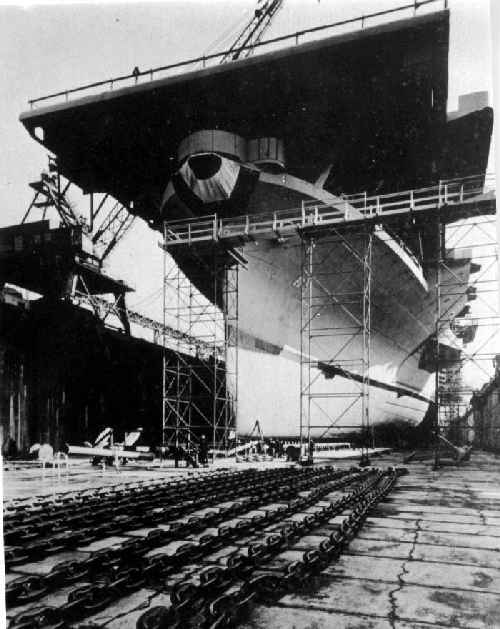
The BENNINGTON's keel was laid at the U.S. Navy Yard, Brooklyn, New York on December 15, 1942. The ship was over 14 months in building, being launched February 26, 1944.
Nucleus crews assigned to the ship were assembled at the Naval Training Station, Newport, Rhode Island and at the Brooklyn Navy Yard early in May 1944. At the same time, Air Group 82 began training at Norfolk.
On August 6, 1944 the BENNINGTON took her place in the largest Navy in the world in simple but impressive ceremonies at New York. Captain J. B. Sykes took official command of the ship as the BENNINGTON's first skipper.
BENNINGTON ENTERS WORLD WAR II IN FINAL STAGES OF THE PACIFIC CAMPAIGN
The ship started her shakedown cruise on October 16, bound for the Gulf of Paria, off the coast of Venezuela. The BENNINGTON was back at Norfolk on November 14, getting its final working-over prior to shoving off for the war zone.
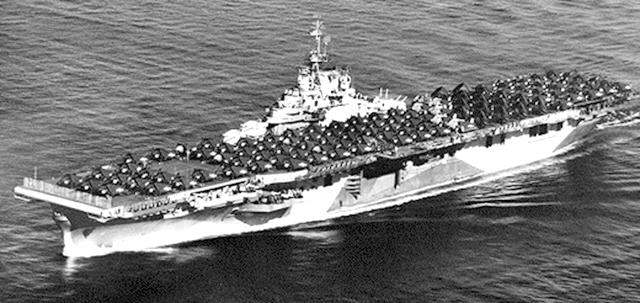
The transit of the Panama Canal was completed by December 22. After a brief stop in San Diego, the ship steamed westward on New Year's Day, 1945 in company with two destroyers. Seven days later, she reached Hawaii.
After three weeks in Pearl Harbor, the ship left for the Far East. The first taste of war came to BENNINGTON as the ship passed close to Japanese held Truk. Enemy planes were reported taking off from the island and the first general quarters was sounded. The attack never materialized however, and the ship continued unmolested into the anchorage at Ulithi where the huge armada of ships amazed even the old-timers.

Early in February the BENNINGTON left Ulithi as part of Task Force 58, bound for Tokyo and the first carrier offensive against the Japanese homeland. Strike objectives were the destruction of Japanese planes, aircraft installations and shipping. Enemy planes were in the air sporadically but the combination of bad weather and surprise along with early neutralization of the airfields prevented any serious enemy air opposition. The flak was heavy over Tokyo and Yokosuka, however, and the BENNINGTON lost her first plane.
On February 19, the air group's planes flew continuous beachhead support strikes over Iwo Jima, where invasion landings were already in progress. Constant air cover gave effective protection from Japanese planes to the Marines and, in addition, served as aerial artillery in blasting strong points.
KAMAIKAZE
 The next big strike to materialize took place at
Okinawa on the first of March.
Following this were 10 days at anchor at Ulithi.
It was while anchored here that a kamikaze plane slipped in one night,
damaging the USS RANDOLPH while she was at anchor a short distance away from the BENNINGTON.
The next big strike to materialize took place at
Okinawa on the first of March.
Following this were 10 days at anchor at Ulithi.
It was while anchored here that a kamikaze plane slipped in one night,
damaging the USS RANDOLPH while she was at anchor a short distance away from the BENNINGTON.
The ship headed north again and the 18th of March found her 80 miles off Kyushu on the Japanese homeland. The prime objective of this strike was the Japanese Air Force - in the air or on the ground. Fifty-seven enemy planes were definitely shot down or destroyed by strafing on March 18th and the 19th, while another 35 were counted as damaged by BENNINGTON planes. Also damaged off Kure was a Yamato class battleship.
BLASTS CONVOY
On March 23rd, the BENNINGTON joined in an intensive, weeklong assault on Okinawa in preparation for the invasion of that island fortress gateway to Japan. High mark of the week was the spotting of a Japanese convoy in the East China Sea, including three heavily loaded cargo ships escorted by a pair of destroyers. BENNINGTON planes joined air groups from other carriers of Task Force 58.1 in sinking the entire convoy.
Easter Day, 1945 came on April 1st, the day of the invasion of Okinawa. The air group's planes were in the air as the first waves of Marines stormed the beach, beginning an air support operation that was to continue for 70 days. During this period, stepped-up kamikaze raids provided several "field-days" for BENNINGTON fighter pilots. On April 6th, 31 Japanese planes were splashed with no loss of our aircraft. A week later, the squadron shot down 34 planes with only one BENNINGTON pilot downed. A rescue plane later picked him up.
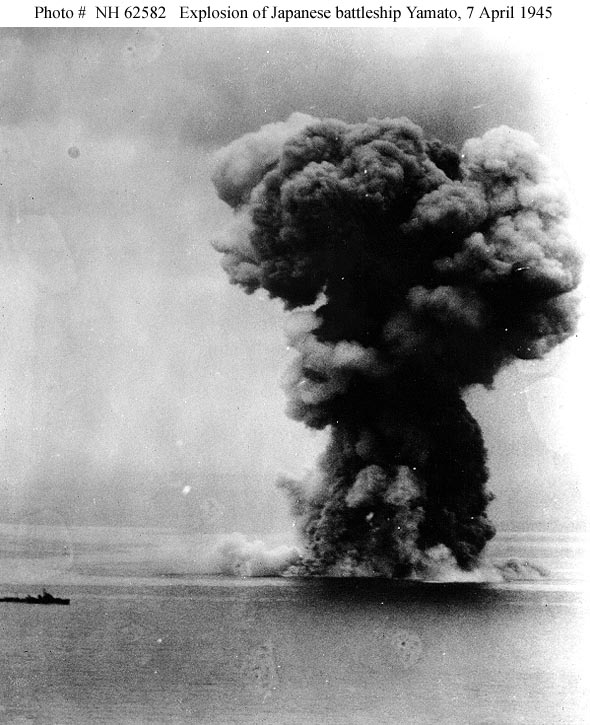
|
Over 300 carrier planes went into action a gainst a Japanese task force off the tip of Kyushu on April 7th. The main target was the huge, modern battleship, YAMATO. It was sunk in one of the fiercest air attacks in naval history. |
TYPHOON STRIKES
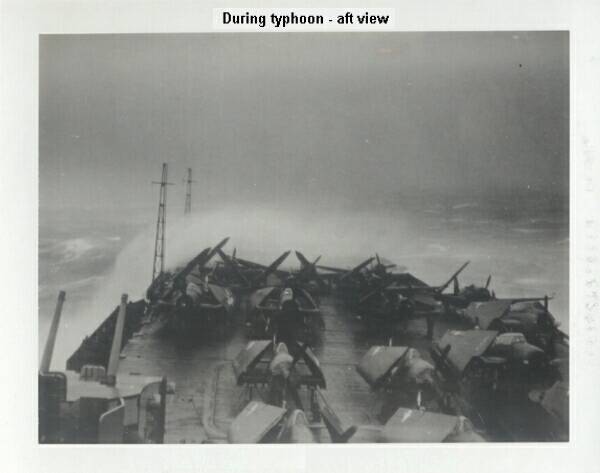
The most serious damage the BENNINGTON was to suffer in the war did not come at the hands of the Japanese. A typhoon with winds in excess of 90 knots overtook the ship at daybreak of June 5th. The powerful seas, with waves estimated at 40 to 50 feet from trough to crest, flooded the forecastle deck and wrecked the forward passageways and living quarters. The forward 25-foot section of the flight deck was buckled, putting both catapults out of commission.
The ship put into San Pedro Bay on June 11th and anchored for 20 days while repairs were made. Air Group 82 was detached for return to the States.
NEW SKIPPER
On June 30, 1945 Captain Sykes was relieved of the BENNINGTON's command by Captain B. L. Braun.

The BENNINGTON returned to the action on the first of July with her new Air Group One aboard. For the next six weeks, operations were conducted against the Japanese homeland. On the 9th and 10th of August, the planes unleashed an attack on the airfields and shipping in Northern Honshu.
Near the war's conclusion, events happened at an accelerated pace. The USSR entered the war against Japan and the world was soon amazed at the tremendous blasts of the atomic bomb.
News of the war's end came to the BENNINGTON on August 15th. A first strike of planes damaged airfields at the Hyakurigahara Airfield and a second strike of planes was on its way to the target. Another Japanese was shot down over another task group and the momentous news of the "end of the war" seemed in doubt until Admiral Halsey broadcast the news of the surrender of all Japanese forces.
The BENNINGTON was represented at the scene of the surrender as her planes joined hundreds of others when they roared overhead in grand gesture of victory.
RETURNS HOME
The ship remained in the forward area until she returned to Pearl Harbor on October 29, 1945. She returned to the United States on November 7th, 1945, putting in at San Francisco.
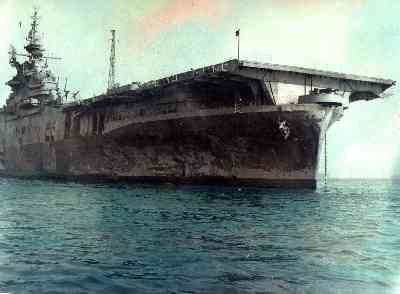
One more trip to Pearl Harbor to transport planes and personnel was made. The ship returning to San Francisco on March 30th, 1946. She crossed the Panama Canal in mid-April and arrived at Norfolk on April 22nd. A short run to Yorktown to unload ammunition was the last for BENNINGTON before she was in activated at Norfolk on November 8, 1946.
The BENNINGTON was "mothballed" in the Atlantic Reserve Fleet at Norfolk until she returned to the Brooklyn Navy Yard on October 30, 1950 for conversion.
The information above is a short summary of BENNINGTON's beginnings from her keel laying until she was sent to the Navy Yard in 1950 for conversion to CVA-20. The data used for this article came from a 1952 JET BLAST Article.
Information provided by:
Joseph L. Pires
USS BENNINGTON HISTORIAN
"former" SK3 - Supply Department - S-1 Division
1965-1969
USS BENNINGTON
CLOSEST CARRIER
CLICK THE PICTURE FOR A CLOSE UP
CLOSE THE CLOSE UP WINDOW TO RETURN HERE
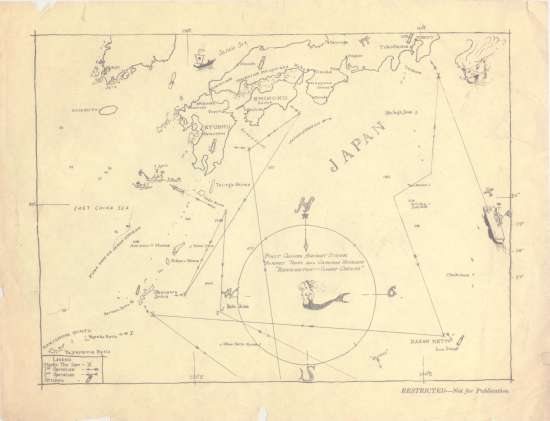
CLICK THE PICTURE FOR A CLOSE UP
CLOSE THE CLOSE UP WINDOW TO RETURN HERE
AND MAY BE SLOW TO DOWNLOAD
Subject:
Closest Carrier
From:
"Howard Woods" [budwoods@earthlink.net]
Date:
Mon, 12 May 2003 19:59:34 -0400
To:
"'Lonnie Whittaker'" [Lonnie@uss-bennington.org]
Dear Lonnie,
I'm sending along a couple of things that may be of interest.
Attached with this e-mail is a copy of a map showing the Bennington's position during air strikes on Tokyo.
According to this, the Bennington was the closest carrier to Japan during this action!
Regards, Howard
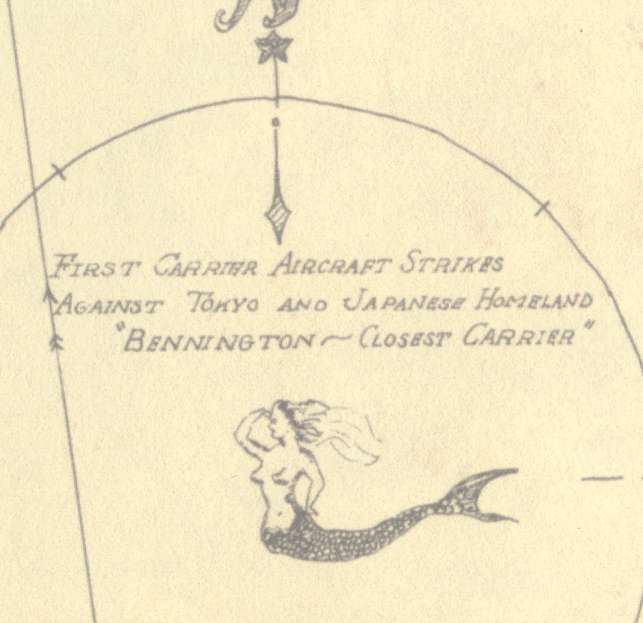
RETURN TO:
RETURN TO: